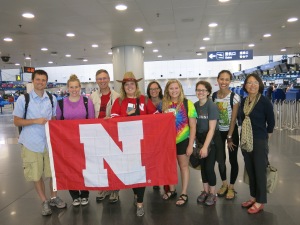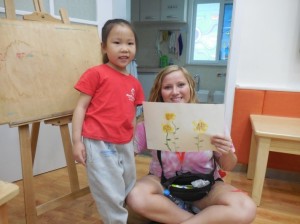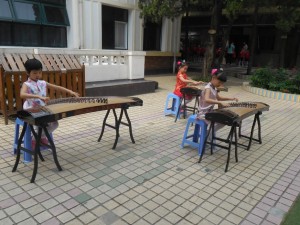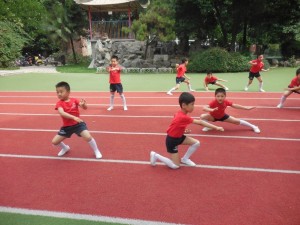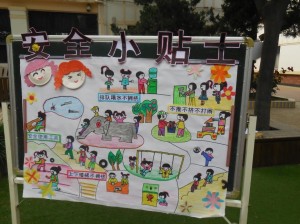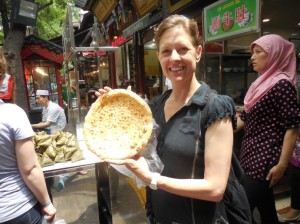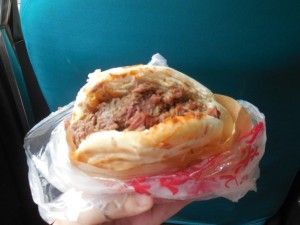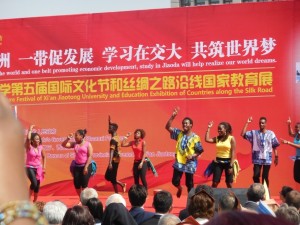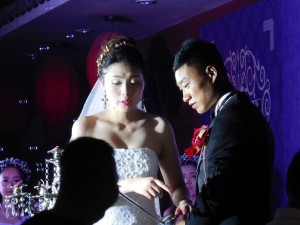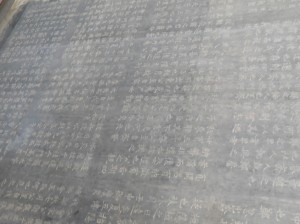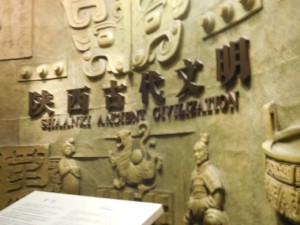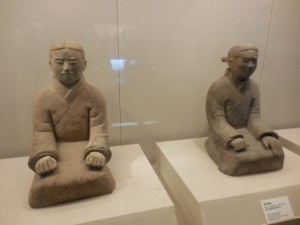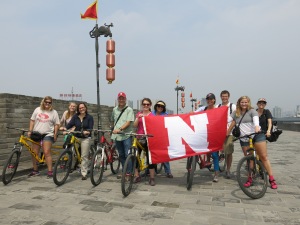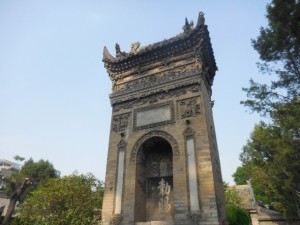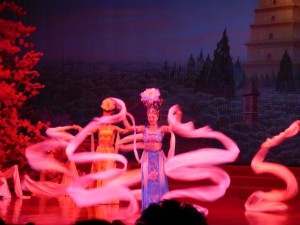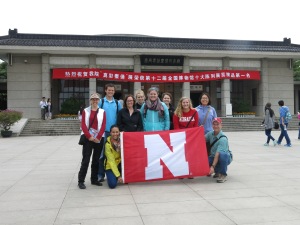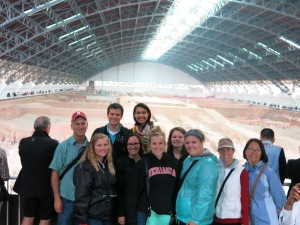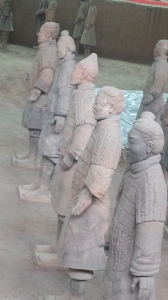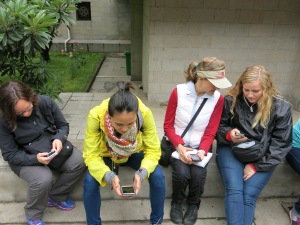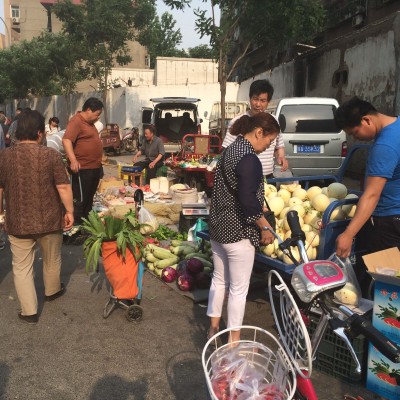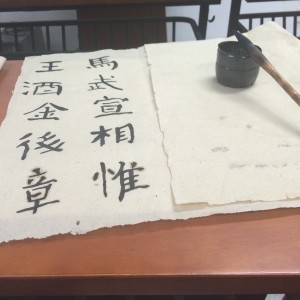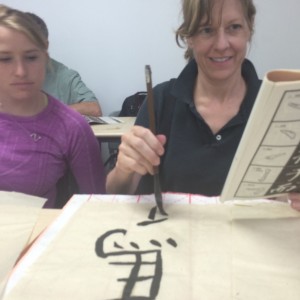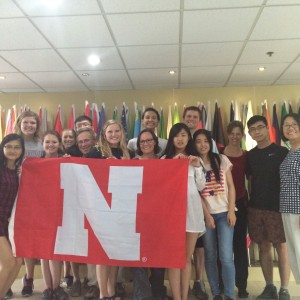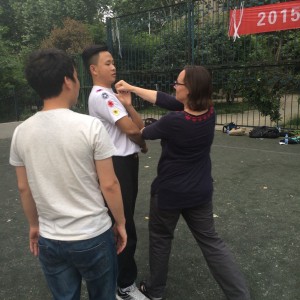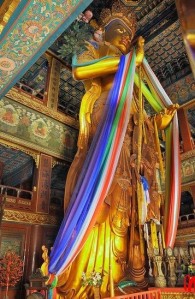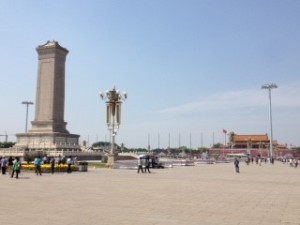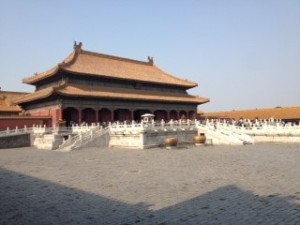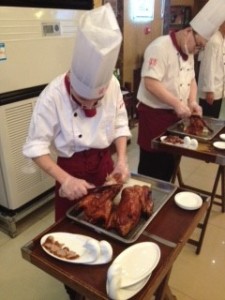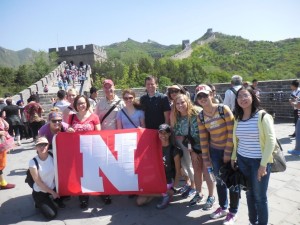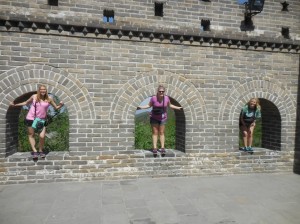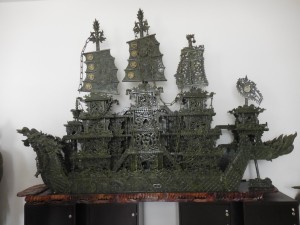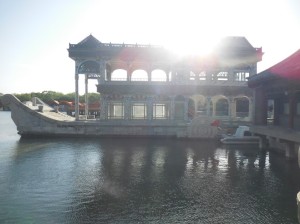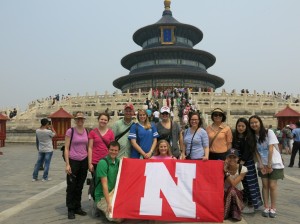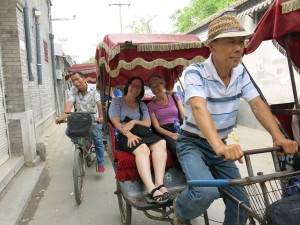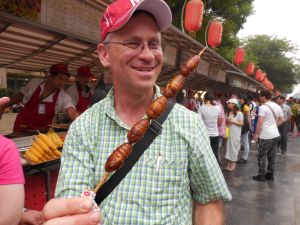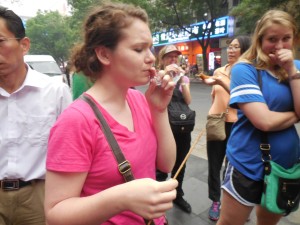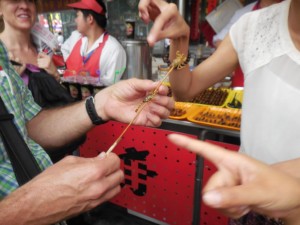by Jan Esteraich
This was our last full day in Xi’an…Rich, Bethany, Kelley, Jenae, Natalie and I were up and out the door at 6:45am to go to the park. We wanted to join a Tai Chi group to get some eastern exercise, and we anticipated the Tai Chi’ers would start early and end early. And, this was our last chance to really take in the elegance and beauty of the Chinese gardens.
Again, the park was humming with all kinds of activity: fierce games of ping pong, spinning tops with a whip, fan dancing, jazzercise, singing groups, ribbon dancing, a saxophone group. Rich, Natalie and Jenae tried their hand at spinning a top with a whip. This is a difficult task, given the weight and length of the whip.
The women then found a Tai Chi group and we joined in, trying to follow the flowing movements of the Tai Chi Master, who was appropriately dressed in a white robe and pants. Although the movement is low impact, my heart was beating fast and my arms were getting a good workout. Note to self: Find a Tai Chi group to join in Omaha (where I live).

Natalie and I walked around the park’s lake and again I saw the four elements found in a Chinese garden: The traditional Taihu rock (although other rock can be used), plants, water, and a pavilion. These elements together offer serenity and relief from the hustle and bustle beyond the park’s edge. After sauntering for about an hour, Natalie and I headed back to the dorms. Internet access in Xi’an had been a little sketchy, but we did discover a coffee shop close by, where, for a cappuccino, we could get online. We had a little time to go to the café and make some Face Time calls to our loved ones.
Today was the day we split into small groups and visited families in various parts of Xi’an. The family was having us over for lunch and conversation. At 11:10 we walked as a group to the university gate to flag taxis. Natalie, Jenae and I went to a home in the western part of the city; the area known for producing airplane engines and parts. The 30-40 minute cab ride (for a fare of under $10) took us to a high-rise apartment complex. Cavin, our host for the day, was waiting for us at the curb. He was a university graduate, in his mid-late 20’s, currently working at a company that arranges international study abroad experiences in the UK for Chinese university students. As we were chatting during the walk from the street to the apartment high-rise, we noticed he had a British accent. Cavin also spent part of his university experience at Sheffield College in the UK.
The apartment complex was about 10 years old, and Cavin had lived there with his parents for the last 8 years. It is not uncommon for young adults to live with their parents after high school or college, before they get married. The 11th floor apartment had 3 bedrooms, 2 baths with galley kitchen and large living/dining room, probably about 1400 square feet. They family also owned a car, which was parked underground.
We were greeted by Cavin’s girlfriend, Daria, who was sitting in the living room, making pot stickers for our lunch!

Daria and Cavin went to high school together and she is currently getting a graduate degree in mathematics. Cavin’s father appeared from the kitchen to say hello and tell us he was cooking lunch today. We said ni hao and thanked him for his graciousness. Cavin kindly translated for us, and then we joined Daria in making the dumplings. She showed us how to hold the circle of pastry, put just the right amount of pork filling in it, fold in half and pinch. Lunch was a scrumptious 9-course meal… with tea and a taste test of Cavin’s home-brewed mulberry wine.

The conversation flowed easily between all of us, giving us the rare opportunity to ask each other questions and have immediate back and forth discussion. We covered a lot of topics, but probably the one that interested me the most was about his view on the one-child policy. He thinks it is a good thing for parents to have 2 children, so the children can share the responsibility of taking care of the parents as they age, and one child is not burdened with all of the care. He confirmed what we had heard before – children have a responsibility to take care of their parents when they are elderly. The parents take care of the child through childhood, and very often take care of children’s children (their grandchildren) until the grandchildren go to preschool or primary school. As reciprocity (another very important value in the Chinese culture), the children take care of the parents as they age. Cavin asked about America’s retirement communities and nursing homes. He said if he were to put his father or mother in a retirement community or nursing home, people would think he was a “bad” child. He said the parents sometimes live with the children, and sometimes live very near the children. His father’s father (Cavin’s grandfather) was in the apartment high-rise right next to his. The grandfather’s apartment can be seen from their kitchen window. Cavin’s father visits his dad everyday. He said that if he and Daria get married and have children, he would like to have two.
During lunch Cavin offered to take us to the nearby market, where the locals go on a daily basis to buy their food. But before we went to the market, we stopped at the monument marking the beginning of the Silk Road. We snapped some pictures and headed for the market. We found a bonanza of fruits and vegetables, fish, meat, poultry, tea, eggs, mushrooms, you name it.


We told Cavin that the watermelon we’ve had in China is some of the best watermelon we’ve ever tasted…What did he immediately do? He bought us all big slices of the delicious treat. We also walked by a Chinese liquor store, where he knows the owners. The owners welcomed us in and gave us samples of his white wine, and the very potent Chinese vodka. We all tried a swallow. Wow, keep that stuff away from flames, because it could ignite. And, then Cavin suggested we go to a tea store, as Natalie and I were asking where we could buy good loose leaf tea.
What a delightful experience we had at the tea store. We had a tea service, sampling green and black and jasmine tea. Natalie and I settled on the jasmine tea…can’t wait to try it.
After we traded email addresses, Cavin walked us back to the street, hailed a cab, gave the cabbie directions, and we were on our way home.
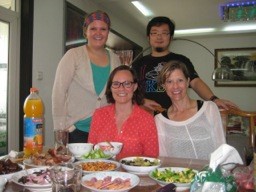
All three of us thought the visit could not have gone better. On the way home we talked about Cavin’s easy-going personality and his generosity in taking the time to show us around (Daria, the same). Personally, I thought being in the family’s home and having lunch with them at their table offered an intimacy and an automatic openness that usually can’t be reached at restaurants or cafeteria settings. Our conversations were immediately relaxed and informal, offering a nice compliment to discussions we’ve had in a big, formal group setting.
Back to the dorm and we had a little free time. Jenae suggested we visit the Education Discovery store we saw at dinner the other night. Natalie, Sarah, Jenae and I trek to the mall, expecting a toy store. When we walk off the elevator, we see it is some sort of club for young children and parents. We inquire at the front desk. A cheerful young woman offers to show us the club. Sure! We would love to see the inside of a Kid’s Club in China. During the tour we learned that parents bring their 0 – 6 year olds to the club for enrichment classes. The classes may be art, gross motor development, learning English. The parent can sign the child up for a number of different options, ranging in cost from $20 to $40 for a 50-minute session. The parents can also take classes with the child, or separately themselves. This visit confirmed what we had heard before: Chinese parents sometimes/often sign their children up for extra activities outside of school (or in this case, before school entry) to give them the best opportunities they can afford. Sidebar: Jenae got offered a job. Our tour guide wanted to hire her on the spot (it was half jokingly said, but half in earnest too!) . Jenae certainly received an invitation to return Xi’an…for a part-time job perhaps? J
Finally, we all reconvened at a restaurant to share our small group experiences. We were all a bit weary at dinner, and thinking about having to pack for our journey to the airport the next day. I am looking forward to visiting the pre-school tomorrow morning…

